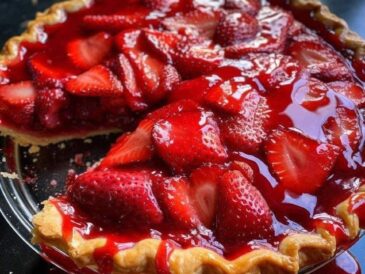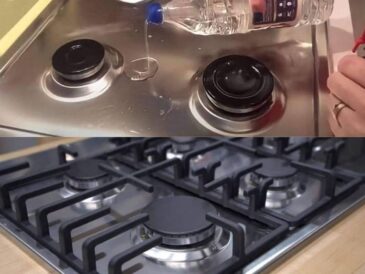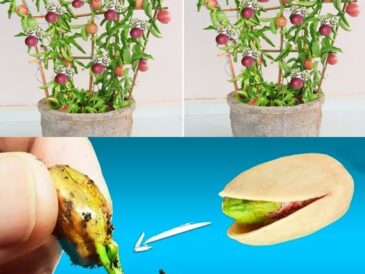Kitchen cabinets are notorious for accumulating a greasy film over time, especially if you love cooking. This sticky grime, often a mix of cooking oils, dust, and other airborne particles, can be a real eyesore and a headache to clean. Grease from frying, simmering, and even the occasional splatter seems to accumulate and coat everything it touches. It often settles onto your cabinets, particularly those near the stove or in high-traffic cooking areas. Over time, this grease can harden, attract dust, and create an unsightly layer of grime that can be both frustrating and time-consuming to remove.
Many people resort to harsh chemicals and elbow grease to tackle this issue, but my aunt taught me a simple trick that makes the process almost effortless. In this article, I’ll share this brilliant method that has saved me time and energy, and left my kitchen cabinets looking brand new.
The Problem with Greasy Cabinets
Before we dive into the solution, it’s essential to understand why kitchen cabinets get greasy in the first place. When you cook, tiny particles of oil and grease get released into the air. These particles eventually settle on surfaces, and kitchen cabinets, especially those near the stove, become prime spots for grease buildup. The cooking process often sends oil particles flying through the air, where they attach to surrounding surfaces, including the walls, counters, and, yes, your cabinets. This is especially true if you’re frying foods or cooking at high heat.
Over time, this grease attracts dust and dirt, creating a sticky film that can be difficult to remove. The longer the grease sits, the more it hardens, making it even harder to clean. Traditional cleaning methods often involve a lot of scrubbing, which can be tiring and may even damage the finish of your cabinets if done too aggressively. Additionally, some commercial cleaners contain harsh chemicals that can be harmful to both the surface of your cabinets and your health. They may leave behind toxic residues that pose health risks, or the chemicals can strip away the finish, causing your cabinets to lose their shine and luster. That’s why finding a gentler, more effective method is crucial.
The Magic Solution: Baking Soda and Vegetable Oil
Yes, you read that right. The secret trick my aunt shared with me involves using common household items: baking soda and vegetable oil. This combination might seem counterintuitive at first—after all, why would you use oil to remove oil? However, the magic lies in how these ingredients work together to break down grease and lift grime without the need for harsh scrubbing or chemicals. The best part? These ingredients are readily available, safe to use, and won’t cost you a fortune.
Why This Method Works
Baking Soda
Baking soda is known for its mild abrasiveness, which allows it to act as a gentle scrubber that can break down the sticky, greasy film without scratching or damaging the surface of your cabinets. Unlike harsher abrasives or scrubbing pads, baking soda works to lift away the grime while being kind to your cabinet’s finish. It’s also a natural deodorizer, which means it helps eliminate any lingering smells that might be trapped in the grease. When baking soda is mixed with oil, it forms a paste that is thick enough to cling to the greasy spots and effectively break them down. It’s a gentle, yet effective, method that doesn’t require heavy-duty scrubbing.
Vegetable Oil
This might sound strange, but vegetable oil actually helps dissolve the existing grease. The science behind this is “like dissolves like.” Grease is oily by nature, and oil is a great solvent for other oils. When you apply a small amount of vegetable oil to the greasy surface, it loosens the grip of the existing grease, making it easier to wipe away. The oil essentially breaks down the greasy film, and because it is a natural product, it won’t harm your cabinet surfaces. Moreover, vegetable oil adds a slight sheen to your cabinets, enhancing their appearance without making them look oily or greasy. The key is to use just enough to dissolve the grease without leaving a heavy residue behind.
How to Use the Baking Soda and Vegetable Oil Method
Here’s a step-by-step guide to using this simple, effective trick to get your kitchen cabinets looking pristine again:
What You’ll Need:
- Baking soda
- Vegetable oil (any kind you have on hand will do)
- A soft cloth or sponge
- A bowl
- Warm water
Steps:
1. Create the Cleaning Paste
In a small bowl, mix together one part baking soda with one part vegetable oil. You don’t need a lot; start with a tablespoon of each, depending on the size of the area you need to clean. Stir the mixture until it forms a thick paste. The consistency should be thick enough that it won’t run off your cabinets when you apply it, but still smooth enough to spread easily.
If you have a larger area to clean, you can adjust the amounts proportionally. This paste will be your cleaning solution, and it will work wonders on lifting grease from your cabinets.
2. Apply the Paste
Dip a soft cloth or sponge into the paste. Then, gently apply it to the greasy areas on your cabinets. You don’t need to press hard; just make sure the paste covers all the greasy spots. Pay close attention to areas that are particularly greasy or have visible buildup. If the grease is caked on, apply a slightly thicker layer to those areas.
It’s important to be gentle during this step to avoid damaging the finish of your cabinets. You don’t need to scrub aggressively—just apply the paste evenly and let it do the work.
3. Let it Sit
Allow the paste to sit on the cabinets for about 5-10 minutes. This gives the mixture time to break down the grease and grime effectively. The baking soda will gently work to lift the grease, and the vegetable oil will dissolve the sticky residue. During this waiting period, you’ll notice that the paste might start to dry slightly or change color as it works on the grease.
4. Wipe Away the Grease
After letting the paste sit, take a clean cloth or sponge dampened with warm water and gently wipe away the paste. You’ll notice that the grease and grime come off easily, leaving behind a clean, smooth surface. For tougher spots, you can use a bit more paste and repeat the process. The vegetable oil and baking soda will leave the surface clean and grease-free, with no residue left behind.
5. Rinse and Repeat (If Necessary)
If you still see some grease residue, repeat the process until your cabinets are completely clean. For most people, one application is enough, but particularly stubborn grime might need a second round. Just apply the paste again, let it sit, and wipe it away.
6. Final Rinse and Dry
Once you’ve removed all the grease, wipe down the cabinets with another clean cloth dampened with warm water to remove any remaining residue. This will ensure that no oil or paste remains on the surface. Finally, dry the surface with a dry cloth to prevent any water spots or streaks. The drying process is important because it helps prevent water marks from forming on your cabinets.
Additional Tips for Maintaining Grease-Free Cabinets
Once you’ve cleaned your cabinets, you’ll want to maintain their fresh appearance. Here are some extra tips for keeping your cabinets grease-free:
1. Regular Cleaning
To prevent grease buildup, make it a habit to wipe down your cabinets with a damp cloth regularly, especially after cooking. This routine maintenance will help keep your cabinets clean and reduce the need for deep cleaning. A quick wipe-down after each cooking session will prevent grease from building up and make it easier to maintain your cabinets over time.
2. Use a Grease Filter
If you do a lot of frying or high-heat cooking, consider using a grease filter in your kitchen. These filters can help trap some of the airborne grease particles before they settle on your cabinets. A good grease filter in your range hood can significantly reduce the amount of grease that gets deposited on your cabinets.
3. Avoid Harsh Chemicals
Stick to natural cleaning solutions like the baking soda and vegetable oil mixture or other gentle cleaners. Harsh chemicals can damage your cabinets’ finish and pose health risks. By using natural cleaning solutions, you’re also helping to preserve the environment by reducing your use of toxic chemicals.
4. Consider Cabinet Material
Different cabinet materials might require different care. For instance, wooden cabinets might benefit from a gentle wood cleaner or polish after using the baking soda and oil method. Be sure to know your cabinet material and use appropriate products to maintain their beauty.
Conclusion
My aunt’s trick of using baking soda and vegetable oil to clean greasy kitchen cabinets is a game-changer. Not only is it incredibly effective, but it also requires almost no effort and uses ingredients you likely already have in your pantry. This method allows you to clean your cabinets naturally and effectively, without the need for harsh chemicals or excessive scrubbing. The next time you notice a greasy film on your cabinets, skip the harsh chemicals and give this simple solution a try. You’ll be amazed at how easy it is to restore your cabinets to their original glory!




